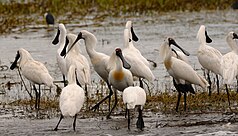Forest Den National Park
| Forest Den National Park | ||
|---|---|---|
| Moluccan ibis ( Threskiornis molucca ) | ||
|
|
||
| Location: | Queensland , Australia | |
| Specialty: | Water holes with eucalyptus, birds | |
| Next city: | Aramac | |
| Surface: | 58.9 km² | |
| Founding: | 1991 | |
| King spoonbill ( Platalea regia ) | ||
The Forest Den National Park (English: Forest Den National Park ) is a national park in the center of the Australian state of Queensland .
location
It is located 991 kilometers northwest of Brisbane , 170 kilometers north of Barcaldine and 180 kilometers southeast of Hughenden .
National nature
Located in the middle of the semi-arid hill country of eastern Queensland, the park's permanently filled billabongs ( German : water holes) are important. The Torrens Creek , a tributary of the Cooper Creek , flows through the park from north to south. For more than 100 years the area of the park was used as pastureland, of which only a few remains of fences can be seen today.
Flora and fauna
Eucalyptus forest has settled around the billabongs , especially River Red Gum ( Eucalyptus camaldulensis ) and Coolibah ( Eucalyptus coolabah ). The park was originally established to secure the stands of Black Gidgee ( Acacia pruinocarpa ) on the western edge of its range.
At the Billabong you can in the twilight birds, like the Whistling Kite ( Heliastur sphenurus ), the goshawk hawk , the Australian White Ibis ( Threskiornis molucca ), the royal spoonbill ( Platalea regia ), the Anhinga , the white-necked heron , other herons , the blue-winged kookaburra , the Rostkehl - Watch the honey-eater ( Conopophila rufogularis ) or the letter pigeon . Also Sugar Glider and common brushtail possum found one of the watering holes.
Facilities and access
Wild camping in the park is allowed, but there are no special facilities.
The park is east of the partially unpaved road from Aramac to Torrens Creek , about 100 kilometers north of Aramac. The use of an all-wheel drive vehicle is recommended. Even small amounts of rain can still make the slopes in the park impassable.
Web links
- Official site of the park (English)
Individual evidence
- ↑ Australian Government - CAPAD 2010 ( MS Excel ; 170 kB), DSEWPaC , accessed on January 7, 2013 (English)
- ↑ Australian Government - CAPAD 1997 ( MS Excel ; 93 kB), DSEWPaC , accessed on January 7, 2013 (English)
- ^ Steve Parish: Australian Touring Atlas . Steve Parish Publishing. Archerfield QLD 2007. ISBN 978-1-74193-232-4 . P. 10
- ↑ a b c d e Forest Den National Park . Department of Environment and Resource Management. Retrieved November 9, 2012


